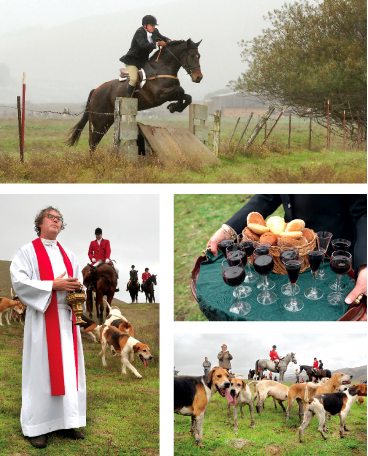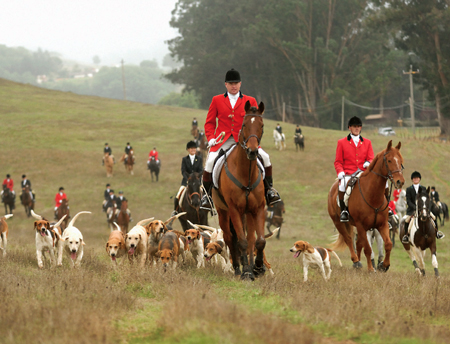Under damp skies on a gray West Marin morning, the Reverend Cyril O’Sullivan is a beatific presence in his white cassock, standing tall amid the oaks and boulders behind Nicasio’s St. Mary’s Church. In his rolling Irish brogue, he extols the virtues of “joy, loyalty and companionship” he deems inherent in the restless congregation gathered before him.
The heavenly ideals invoked by Father O’Sullivan fall on inattentive ears, however. His unruly flock is far more interested in earthly matters, pacing to and fro and sniffing the ground. Only when sprinkles of holy water startle them into attention do they have a chance to hear the blessing meant to “keep them safe and free from harm.”
Then, benediction complete, the huntsman’s horn blares forth with an emphatic blast, and the two dozen tricolored foxhounds are off, leading an equally eager group of 30 smartly attired equestrians out of the pasture. A passel of motorists and bicyclists provide an enthusiastic audience for the colorful scene.
The riders, all members and guests of the Los Altos Hounds, are participating in one of the club’s annual Marin hunts, one of 20 similar Northern California events it hosts between November and April. (The club also sponsors timed cross-country rides, a Peninsula barn tour and a season-ending ball. Membership, says Woodacre resident Linda Albion, is open to anyone “who just wants to have good, adrenaline-filled fun.”)
Although the hunt has begun with a flourish, it came together in more measured fashion. An hour before the traditional blessing of the hounds, the pack was still ensconced in the horse trailer that had trucked its members north from their Hollister kennel. Only their prized soft noses, poking through slats of the trailer, were visible. Pedigreed from American and European stock, some with bloodlines dating back to the 1700s, the hounds number about 75.
The ranch on Nicasio Valley Road that serves as the hunt’s staging area and breakfast venue had filled slowly. One by one, as curious cows watched, horse trailers arrived and unloaded their cargo—athletic, beautifully built mounts. The animals, some with their manes knotted into intricate braids, stood patiently tethered to their trailers, munching on hay while being groomed.
The riders, ranging in age from four-year-old Clare Bever astride her gray pony to 80-year-old master emeritus Albert Schreck on his Percheron-Thoroughbred cross, exchanged cheery greetings in the brisk chill, nibbled on scones and sipped beverages from “stirrup cups.”

Father O’Sullivan’s request for divine guardianship didn’t extend to the resident foxes and coyotes of West Marin, but they are protected by Marin sensibilities (and the Marin Humane Society). Here, unlike other places where the club rides, fox hunting is prohibited. What the hounds “hunt” is a sponge soaked in coyote urine that two advance riders drag in front of the pack.
That’s just fine with Albion, who’s hunted with the club for 20 years and who cochaired today’s breakfast. “I’ve hunted in England, Ireland and Virginia and have done a lot of soul-searching because I’m such an animal [rights] activist,” she says. “Basically, most of us just like the friendship and the excitement of galloping across the countryside, not the hunting.”
The riders fall into two groups, says Joint Master of Foxhounds Jef Graham of Portola Valley. “One who hunts to ride and one who rides to hunt.” The latter consists of those who appreciate how the hounds work a scent.
“‘Riding to hounds’ is mostly about the chance to spend a day in the country and ride in beautiful places,” says Graham. “We don’t
really get anybody who wants to hunt things.” By dealing with ditches and roads, long grasses and various obstacles, he points out, riders learn to be better horsemen.
With or without prey, the hounds enjoy the run and so do the horses. Typically, “90 percent of riders [and their horses] never leave the barn,” says Graham, “and what horses love the most is running in open spaces with other horses. They adore it.”
This is a sport steeped in tradition. A defined club hierarchy, responsible for maintaining the club and the kennel, is honored. So are the specialized rules, dress code and language, based on unfailing courtesy as well as practical considerations, dating back to hunting’s earliest days in Europe.
During the hunt, for example, hounds have the right of way; beginning hunters stay to the rear; conversation is kept to a minimum; and “there’s a God-spoken rule that you never pass the field master,” Albion says with a chuckle. “Lightning will strike if you do.”
The riders are grouped in two “fields,” one whose members want to jump and one whose don’t (the latter are called hilltoppers). A crew opens and closes the gates; a huntsman is in constant communication with the hounds; “whippers-in” keep errant hounds from following other scents or prey; and the field masters look after the riders.
Staff and veteran club members get to wear the eye-catching scarlet coat that is easily spotted by the field. The scarf at the neck, secured by a gold stock pin, makes an emergency splint for horse, hound or human. The tan tops of men’s field boots recall earlier cuffed ones that would be pulled up for protection against the underbrush and folded over for after-hunt functions. And the long whip can snare a loose horse or open a gate.
The hounds—never referred to as dogs—are counted in couples. They don’t wag their tails; they “flag their sterns.” They don’t bark, but rather “speak” or “cry,” and when they’re “in full cry,” their sound is “music.”
“Tally-ho” means game is sighted; “ware hole” warns another rider of a potentially dangerous pothole, and “come-a-cropper,” or falling headfirst from a mount, is something no rider wants to experience.
“Injuries are few,” says Graham, “and most happen not when going over a jump, but when mounting incorrectly after closing a gate or picking up a glove.”
The hounds pay close attention to the huntsman’s horn. Different blows signal different cues—one telling them to gather, another to search for scent and still another to stop hunting. That one, a long, mournful and haunting note called “coming home,” is ceremoniously blown at the funeral of a club member, often with his boots placed backwards in the stirrups of his horse. “It brings tears to everybody’s eyes,” Albion says.
After an exhilarating if moist two-hour ride, the group sits down to a breakfast served at colorful tables arranged pondside. Albion, along with Catherine Barnes of Nicasio and Holly Sichel of Santa Rosa, has set up a buffet of salads. Holly’s husband, Rodney, who is serving as the liaison for the ranches, also serves up 100 pounds of barbecued tri tip and sausage and bottles of his family’s vintage-vine zinfandel wine. Dessert is carrot cake.
It is a fine finish to a day of riding to hounds. “We never have to ask how much fun someone’s had,” Albion says. “We can always tell by the amount of bugs and mud in their teeth!”
Images: top: A rider and horse cross pastures. below left: Father Cyril O’ Sullivan blesses hounds just outside St. Mary’s Church. below top right: “Stirrup cups” of port and hearty scones are offered to riders before the hunt. Carrots, proffered in a silver bucket, are for the horses. below bottom right: exhausted but happy hounds.


